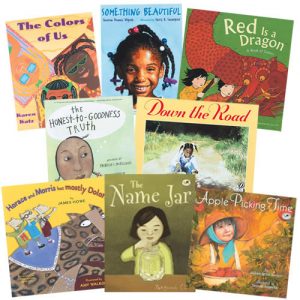It’s just a fact of modern life: we are bombarded with complex realities of race, racial identity and racism everyday. And for many people, the topic can be an emotional and controversial issue that triggers immediate reaction. So, how do we talk about it amongst ourselves, let alone with children?
Discussions about race and diversity can be difficult, but if you want to raise children with a deep capacity for inclusion and empathy, such conversations are inevitable and require care.
In fact, the American Academy of Pediatrics states that children “as young as 6 months can notice race-based differences, and they can internalize racial bias by the age of 2.” (1) As preschool-aged children begin to notice and point out differences in people around them, how can you best promote a healthy understanding of race a diversity with your child?
This parental guide is meant to help you have meaningful discussions with your young children and help them construct a positive sense of their own self and a respectful understanding of others.
A Parent’s Guide To Talking About Race
Adults often think they should avoid talking with young children about race or racism. The reasoning goes that doing so might cause them to notice race or come up with their own misunderstandings, but in fact the opposite is true. When adults are silent about race or use “colorblind” language, they actually reinforce racial prejudice in children (2).
With such an important topic, it can be tough to know how to start an age-appropriate conversation with young kids, but we have you covered. Below are some strategies to start the ongoing discussion about race within your home:
Start Talks Early
At around age 3, kids start to use race, among other things, to make decisions about who to play with. These decisions can reflect biases they’ve unconsciously developed. For this reason alone, parents must actively start conversations about diversity and race at an early age to help promote inclusive attitudes and a healthy understanding of people’s differences.
When you acknowledge that different races exist, and that differences are positive and wonderful, you’re showing your kids that race isn’t a shameful, hush-hush thing. By starting conversations early, you create a safe place where your children can ask questions and learn about the world around them.
Encourage Questions
It’s natural for children to ask questions. But as any parent knows, sometimes a young child’s questions aren’t worded as delicately as we would hope.
Although these early questions might be tough (and sometimes a little cringe worthy or embarrassing), never discourage your child from asking them. If your child has questions about differences in physical characteristics or cultural practices, discuss them openly. This teaches your child that it’s okay to notice differences and, more importantly, that it’s good to talk about them. Learning to appreciate all kinds of differences is an important skill in today’s diverse society.
When your child asks questions, be sure you understand what they’re really asking and why. Is it coming from a place of judgment, or a sincere effort to know more? And where does the need to know more stem from? By breaking down your child’s questions, you can answer the questions in a positive light, look for teaching moments, and instill broad worldview.
Expose Your Children To Diversity
We live in a true melting pot, so look for ways to expose your child to the different cultures and lifestyles that are all around them.
Most communities have free and low-cost cultural events hosted by churches, community centers, schools, and other local organizations. Explore Facebook calendar of events in your area to find kid-friendly experiences such as cultural festivals, art exhibits, and other activities.
Seeing another culture in action is a fun way to gain an understanding about it. Community cultural events and celebrations give your child the opportunity to appreciate people who are different from them. Further, the more your child interacts with different cultures, the more they can respect and value them.
Correct Statements
There will be times when a child might repeat something they’ve heard from friends or an idea they have developed themselves that might not be racially sensitive or correct. In these moments, look to educate and uplift your child rather than shut them down and get upset.
Although you’ll want to quickly discuss and correct these statements, it is important to find out why the comment was made. Ask your child follow up questions about what they mean, why they think the statement is true, or why they said it. When you take the time to understand the root of the idea, you can better adjust and discuss. For example, if your young African American child tells you, “I want to be white,” you might immediately think they are rejecting or dishonoring their racial identity. But with further questioning, you may come to understand that they want to be an astronaut and only see white astronauts. In this case, you can see that they only associate astronauts with caucasian people, and that’s where the racial statement came from. By understanding the child’s thought process, you can address the proper things. In this example, perhaps you’d find African American scientists in your community for your child to meet.
Take the time to understand your child’s questions and teach positive racial identity, connection and inclusion whenever you can. Children believe what they are taught, so be sure you are in charge of the narrative.
Talk About Fairness and Equality
It is quite common for children to complain that things aren’t fair. Since fairness is so important to young children, it is a great place to start conversations about race and equality.
By focusing on fairness, you can create meaningful conversations about equality and how all people should be treated fairly no matter how they look. Children are already noticing patterns in the world around them, and this is your opportunity to help them think critically about what they’re seeing. Help your child look for ways they can make things more equal in the world around them, in their playtime dates, and in their communities.
Set An Example
“Do as I say, not as I do.” It’s a common phrase, but as a parent, you know it’s absolutely true. Children pick up on everything you say and do, so what example are you setting?
If you say something is important, but your children don’t see your behavior match, they’ll learn it’s not actually very important to you. We can tell children things are important, but we must also model that behavior for them.
One way to do that is acknowledging issues of race and racism in forthright, thoughtful, and respectful ways. Whether you join marches for causes you care about as a family, or you invite neighbors over to your house for dinner, it’s important to set your priorities as a parent. Your children will follow your lead.
Read Diverse Books
Lastly, one of the easiest ways to introduce race and diversity into your home is through quality books and media! There are tons of children’s books and movies that teach about different cultures, religions, holidays, and lifestyles. Choose books that acknowledge that all of us are “different” in some way.
Because children’s books are written on a child’s level, they can help you introduce new ideas in an appropriate way and lead to meaningful discussions. If your child wants to learn more about something they’ve seen in a book or movie, spend some time on the internet to gather more information and understanding.
Young children often enjoy repeated readings of the same book (or movie). Take advantage of this natural love of repetition to enjoy meaningful messages again and again if your child requests it. The repeated messages can help children further develop positive mindsets about diversity.
Conclusion
The world is a big and connected place, and it is really important for parents to develop a healthy mindset about diversity with their children. We need to create vulnerable, open, and challenging spaces where children can learn and grow with the world around them. By honestly talking about race, equality, and human kindness, we take steps towards a healthier future.
Here are some books and online resources that can help you promote positive discussions about diversity and race:
- Waterford Civil Rights Day Coloring Page
- How To Promote Diversity In The Classroom
- All Are Welcome by Alexandra Penfold
- Monsters University by Pixar
- Don’t Call Me Special by Pat Thomas
- Lovely by Jess Hong
- The Name Jar by Yangsook Choi
- Separate Is Never Equal by Duncan Tonatiuh
Sources:
- “Talking to Children About Racial Bias.” HealthyChildren.org. American Academy of Pediatrics. Accessed January 22, 2020. https://www.healthychildren.org/English/healthy-living/emotional-wellness/Building-Resilience/Pages/Talking-to-Children-About-Racial-Bias.aspx.
- Winkler, Erin N. 2009. Children Are Not Colorblind: How Young Children Learn Race. PACE: Practical Approaches For Continuing Education, 3(3): 1-8.





